If you’re into FPV (First-Person View) flying, you already know that precision is key. Whether you’re racing through obstacles or capturing cinematic footage, smooth control and stability are a must. That’s where MEMS IMUs (Micro-Electro-Mechanical Systems Inertial Measurement Units) come in. These small, lightweight sensors are at the heart of many FPV systems, giving us the real-time data we need to fly our drones with confidence.
A MEMS IMU is a sensor that measures a drone’s acceleration, angular velocity, and sometimes even its magnetic field. It’s made up of accelerometers, gyroscopes, and magnetometers. These components give us the data to track the drone’s orientation, position, and motion.

So, why exactly are MEMS IMUs essential for FPV? Let’s dive into the details and explore how these tiny sensors make a massive difference in the way we control our drones.
Table of contents
Why MEMS IMU is It Important for FPV?
For FPV flying, MEMS IMU is definitely crucial. We rely on the data to keep our drones stable, precise, and responsive during those high-speed turns and flips.
When we’re out flying, the MEMS IMU provides real-time updates to the flight controller. This ensures that the drone’s movements match our inputs perfectly, making it feel like an extension of ourselves. The IMU processes the data, sending it straight to the flight controller, which then adjusts the drone’s position. This happens in milliseconds—speed is everything in FPV flying!
Key Benefits of MEMS IMUs for FPV:
- Compact and Lightweight: MEMS IMUs are small, making them perfect for FPV droneswhere every gram counts.
- Real-Time Data: Continuous feedback ensures that the flight controllercan adjust flight surfaces instantly, maintaining stability and smoothness.
- High Reliability: These sensors work great in tough conditions, even during high-speed maneuvers or gusty winds.
- Affordable: MEMS technology keeps costs down, making it accessible for both hobbyists and professionals alike.
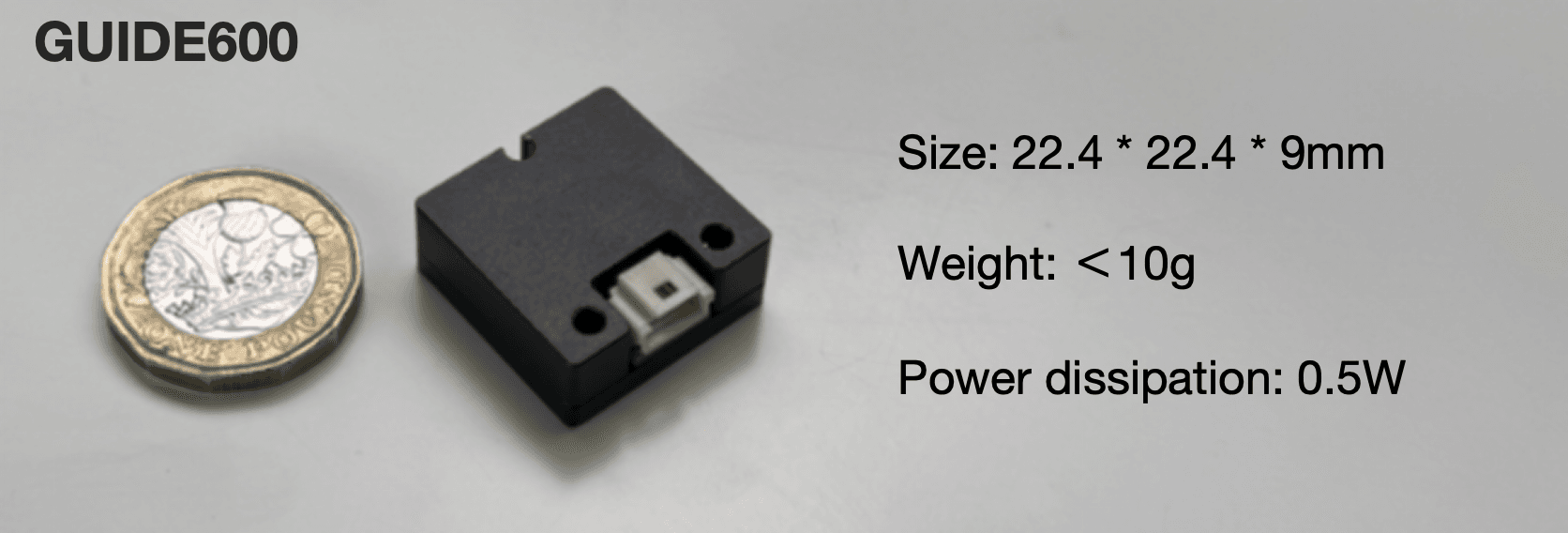
How Does a MEMS IMU Improve FPV Drone Flight?
When it comes to FPV flying, we want our drones to be stable, agile, and responsive. Here’s how the MEMS IMU helps us achieve that:
1. Flight Stabilization and Control
The gyroscope measures how fast the drone is rotating, whether it’s turning, tilting, or spinning. With this info, the flight controller adjusts the roll, pitch, and yaw to keep the drone stable. The accelerometer adds data about the drone’s linear acceleration, helping the controller maintain control over speed and direction. These sensors work together to ensure smooth flight even in the most extreme maneuvers.
When we’re flying through tight spaces, these real-time adjustments from the IMU help prevent sudden drift. The flight controller constantly reads the data, adjusting the drone’s movements instantly, keeping us in complete control.
2. Improved Maneuverability
If you’re into FPV racing or freestyle flying, you know how important quick and precise responses are. The MEMS IMU enhances this by making the drone extra responsive. It ensures that every movement you make is reflected instantly in the drone’s behavior. Whether you’re pulling off a sharp turn or a quick flip, the IMU’s data allows the flight controller to react immediately. No more delays!
This is particularly valuable when you’re navigating through an obstacle course at high speeds or performing complex aerial stunts. With the IMU, you can execute each movement with greater precision, and your drone stays stable even during rapid direction changes.
3. Enhanced Flight Stability
FPV flying can be unpredictable. Wind gusts, sudden turns, and even the vibrations from the drone’s motors can affect its stability. That’s where the MEMS IMU comes in. It tracks the drone’s orientation constantly and sends this data to the flight controller. This helps maintain stability, even when conditions are challenging. As a result, the drone stays level and responsive, making your flying experience smoother.
During long or high-speed flights, the IMU ensures that even if the drone starts to drift off course slightly, the flight controller will adjust accordingly to bring it back to a stable position. This is especially important for cinematic FPV where smooth, stable footage is a priority.
4. Sensor Fusion for Higher Accuracy
Many FPV drones use sensor fusion, which combines data from the IMU, GPS, and sometimes even external vision systems to create a more accurate picture of the drone’s position and motion. The MEMS IMU plays a huge part in this. By combining accelerometer, gyroscope, and magnetometer data, the IMU provides precise information about the drone’s movement, even when GPS signals are weak or unavailable. The fusion of all this data ensures that the drone remains on course with minimal drift or instability.
What to Look for in a MEMS IMU for FPV Drones
When selecting a MEMS IMU for your FPV drone, precision is a critical factor to consider. The gyroscope accuracy—which determines the IMU’s ability to measure angular velocity—is crucial for achieving smooth and precise control, especially in high-speed maneuvers. Let’s explore the factors you should focus on when choosing the right IMU, including gyroscope precision, sensor fusion, and more.
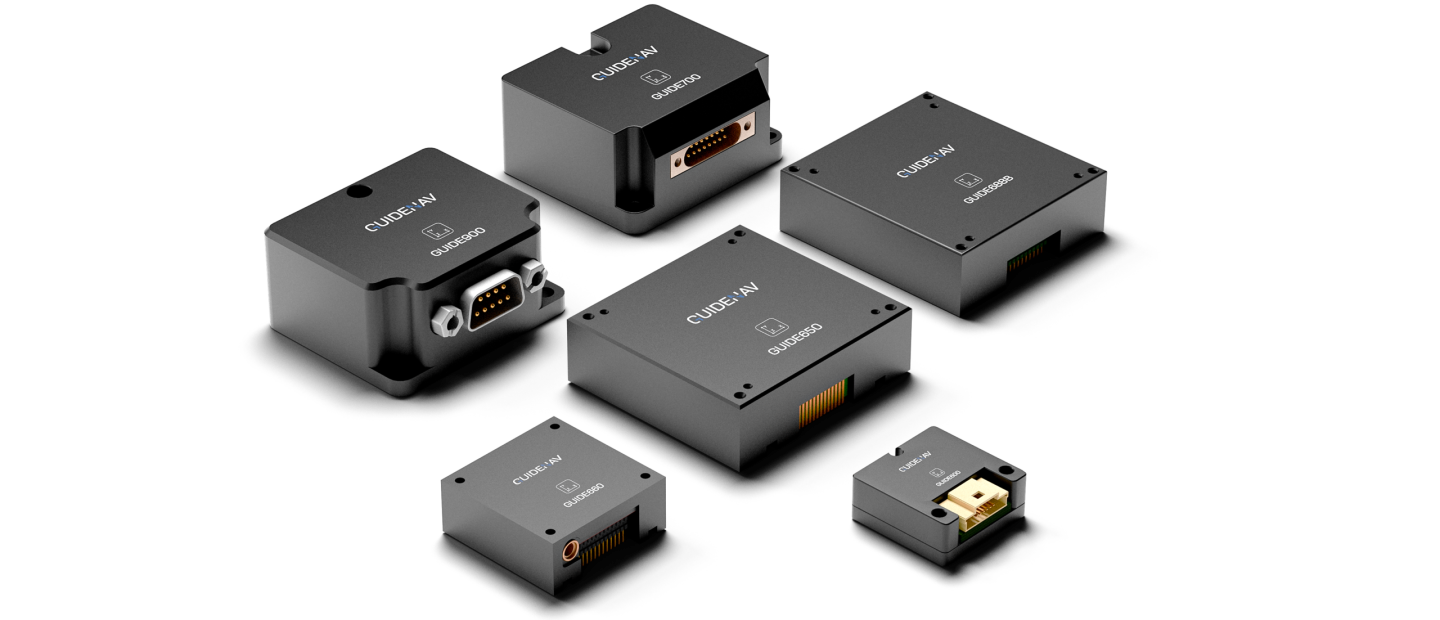
1. Gyroscope Accuracy
One of the most important aspects of a MEMS IMU is the gyroscope accuracy. The gyroscope measures the rotational movement of the drone, and its accuracy directly impacts the precision of the drone’s response to your inputs. Here’s what to keep in mind for different types of FPV drones:
- High-Precision FPV Drones(e.g., racing drones, freestyle drones): For these applications, you’ll want low-drift gyroscopes with a high degree of accuracy, ideally with a bias stability around 01°/hr to 0.1°/hr. These gyroscopes ensure the drone remains stable during rapid movements and changes in direction, which is critical for precise maneuvering.
- Mid-Precision FPV Drones(e.g., general-purpose FPV or casual flying): For drones used in casual flights or less aggressive maneuvers, MEMS IMUs with gyroscopes that have a drift rate of 0.1°/hr to 1°/hr are sufficient. These drones do not require the highest precision but still benefit from stable flight and minimal drift during turns or in windy conditions.
- Entry-Level FPV Drones: For beginner dronesor budget FPV systems, you can find MEMS IMUs with higher drift rates (around 1°/hr or higher). These IMUs are still functional for general flying but won’t perform as smoothly during fast maneuvers or in challenging conditions like high winds.
2. Precision and Drift Stability
The precision of a MEMS IMU, especially the gyroscope, determines how accurately the drone can measure small movements. Look for a low drift rate to maintain stability over long flights and during high-speed maneuvers. If you’re building a competitive FPV drone, ensure the IMU offers high precision, low drift, and fast response time for maximum performance.
3. Size & Weight
While gyroscope precision is critical, the size and weight of the MEMS IMU matter just as much for FPV drones. A lighter IMU will improve your drone’s agility and reduce the overall weight, which is vital for FPV racing and acrobatic maneuvers. Smaller, compact IMUs like the GUIDE688B are perfect for lightweight drones, while heavier, more accurate IMUs may be better suited for larger drones with higher precision needs.
4. Update Rate
The update rate of the IMU determines how often it sends data to the flight controller. For FPV drones, especially those used in racing, a higher update rate (e.g., 500 Hz or more) is essential for real-time adjustments. A higher rate ensures the drone can make quick adjustments during rapid movements or tight turns, keeping your flight smooth and precise.
- Racing & Freestyle Drones: These typically require an IMU with high update ratesto keep up with fast, aggressive flying.
- Casual FPV or Cinematic Drones: These drones may not need extremely high update rates but should still offer reliable performance to ensure stable flight.
5. Power Consumption
FPV drones are often powered by batteries, so choosing an IMU with low power consumption is crucial to extend flight times. MEMS IMUs generally have low power draw, but make sure you compare the power consumption to get the best performance without draining your battery too quickly.
6. Cost
While high-precision IMUs may be necessary for high-performance FPV systems, don’t forget that budget-friendly options are available. If you’re just starting out or flying for fun, you might not need the most expensive, high-precision IMU. For casual flying or entry-level FPV drones, affordable MEMS IMUs with adequate precision and drift stability will work just fine.
| Drone Type | Gyroscope Accuracy (Bias Stability) | Best Use Case |
|---|---|---|
| High-Precision FPV Drones | 0.01°/hr to 0.1°/hr | Racing drones, freestyle drones, and high-performance systems |
| Mid-Precision FPV Drones | 0.1°/hr to 1°/hr | General-purpose drones, casual FPV flying |
| Entry-Level FPV Drones | 1°/hr or higher | Beginner drones, budget FPV systems |
Recommended MEMS IMUs for FPV Drones
Choosing the right MEMS IMU for your FPV drone is crucial, and gyroscope accuracy plays a key role in determining how smooth and stable your flight will be. Depending on your needs, whether you’re a beginner, a casual pilot, or a high-performance racer—the right IMU can make all the difference. Below is a breakdown of GUIDE688B, GUIDE900, and GUIDE600, highlighting their gyroscope accuracy and the best use cases for each model.
1. GUIDE688B: Ten-Axis MEMS IMU (Ideal for Moderate Precision)
The GUIDE688B is a ten-axis MEMS IMU designed for general-purpose FPV drones and moderate precision applications. It integrates three-axis gyroscopes, three-axis accelerometers, three-axis magnetometers, and a barometric pressure sensor, offering a comprehensive solution for drone control.
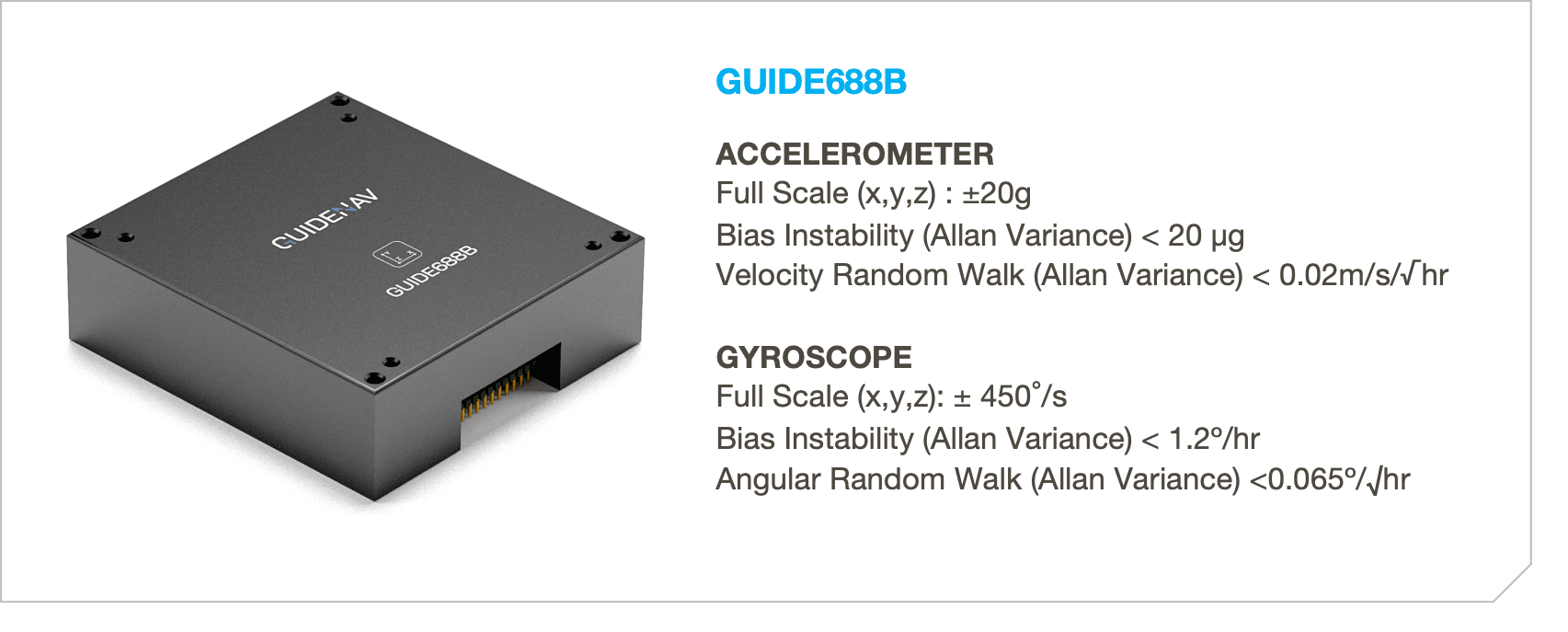
Gyroscope Accuracy (Bias Stability):
- 1.2°/hr
- Precision: Ideal for drones that require moderate precision, such as freestyle flying, or general-purpose FPV drones. While not as precise as high-end systems, it ensures stable flight for most FPV applications.
Best Use Case:
- General-purpose FPV drones
- Casual and freestyle FPV flying
- Moderate racing applications
The GUIDE688B provides solid performance and accuracy for drones where high precision isn’t a must but stability and reliability still matter.
2. GUIDE900: High-Precision MEMS IMU (Ideal for Professional and Racing FPV Drones)
The GUIDE900 is a six-axis MEMS IMU offering superior precision with low drift, making it ideal for high-performance FPV systems. It provides high-accuracy gyroscopes and accelerometers, with performance close to low-end fiber optic gyroscope (FOG).
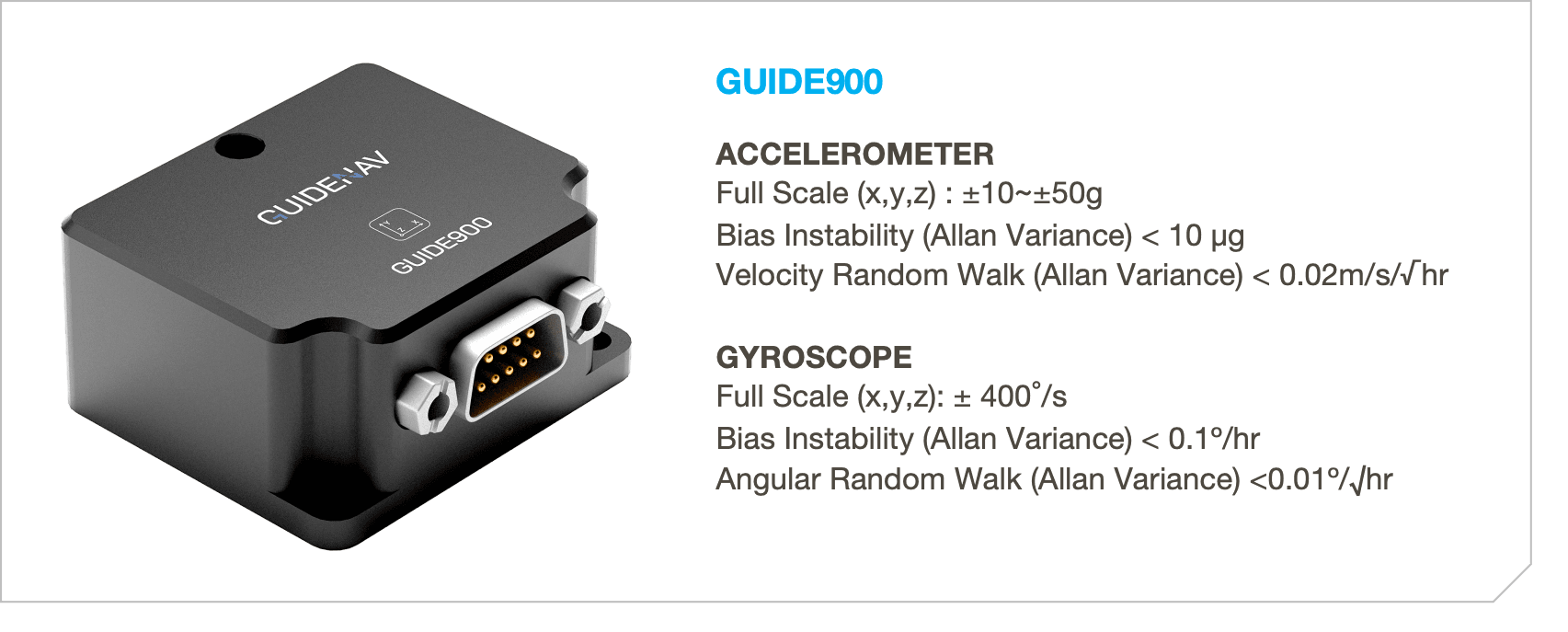
Gyroscope Accuracy (Bias Stability):
- 0.1°/hr
- Precision: This level of accuracy is perfect for FPV racing drones and cinematic FPV systems where ultra-precise control is needed for quick maneuvers, high-speed flying, and stable flight.
Best Use Case:
- FPV racing drones
- High-end cinematic drones
- Professional FPV applications
The GUIDE900 is the top choice for precision and performance. Whether you’re looking for high-speed stability in racing or smooth cinematic shots, this IMU delivers the accuracy needed to elevate your drone flying experience.
3. GUIDE600: Low-Cost MEMS IMU (Ideal for Entry-Level FPV Drones)
For beginner pilots or those looking for a budget-friendly solution, the GUIDE600 is a six-axis MEMS IMU that provides basic functionality at a very affordable price. It’s perfect for entry-level FPV drones where extreme precision isn’t necessary.
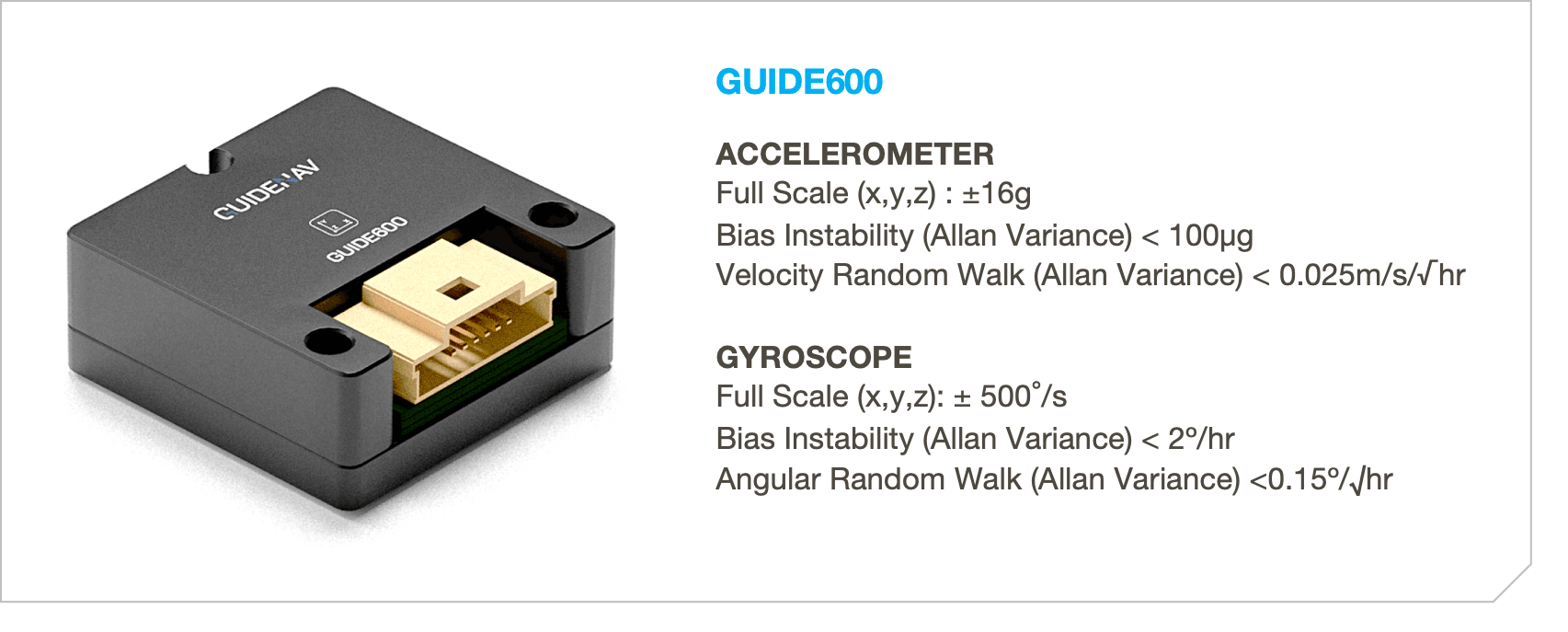
Gyroscope Accuracy (Bias Stability):
- 2°/hr
- Precision: Suitable for casual flying or beginner drones, where lower precision is acceptable. While this level of accuracy isn’t suited for competitive racing, it provides enough stability for entry-level FPV applications.
Best Use Case:
- Beginner FPV drones
- Budget FPV systems
- Casual flying
The GUIDE600 is an excellent starting point for new pilots or those who need a cost-effective solution for basic FPV flying without the need for high-end precision.
